正在加载图片...

EMOTION AND THE BRAIN 163 Auditory Cortex TE1 TE3 PRh Auditory Pathways to Amygdala Circuits A CE Behavior ANS HPA CS tone s involved in fear d几 mulus.the of the eral amy ala (LA)fre ry pro ng areas mus [me (TE3)LA.in tun sion of the medial geniculate body.PRh perirhinal corex TE.primary auditory cortex. s1995.Shi D pathway learns more slowly over trils than does the thalamic pathway (Quirk et al 1995.1997).thus indicating that plasticity in the amygdala occurs initially through the thalamic pathway ent functional m but not the (Morris et al 1999),further emphasizing the importance of the direct thalamo- amygdala pathway. ed to expressing to the eCS,rats also exhibit the e wher in which shocks occur alone This is called contextual fear conditionin and requires both the amygdala and the 92.Maren et al 1997,Kim Fanselow 992.Franklandt EMOTION AND THE BRAIN 163 CE Behavior ANS HPA Defense Responses LA MGm/ PIN Auditory Cortex TE1 TE3 MGv CS (tone) Auditory Pathways to Amygdala Circuits PRh Figure 3 The neural pathways involved in fear conditioning are well characterized. When the CS is an acoustic stimulus, the pathways involve transmission to the lateral nucleus of the lateral amygdala (LA) from auditory processing areas in the thalamus [medial division of the medial geniculate body (MGm/PIN)] and cortex [auditory association cortex (TE3)]. LA, in turn, projects to the central amygdala (CE), which controls the expression of fear responses by way of projections to brainstem areas. ANS, Autonomic nervous system; CS, conditioned stimulus; HPA, hypothalamic-pituitary axis; MGv, ventral division of the medial geniculate body; PRh, perirhinal cortex; TE1, primary auditory cortex. tioned the ability of the thalamic pathway to mediate conditioning (Campeau & Davis 1995, Shi & Davis 1998), single-unit recordings show that the cortical pathway learns more slowly over trials than does the thalamic pathway (Quirk et al 1995, 1997), thus indicating that plasticity in the amygdala occurs initially through the thalamic pathway. Recent functional magnetic resonance imaging studies in humans have found that the human amygdala shows activity changes during conditioning that correlate with activity in the thalamus but not the cortex (Morris et al 1999), further emphasizing the importance of the direct thalamoamygdala pathway. In addition to expressing fear responses to the CS, rats also exhibit these when returned to the chamber in which the tone and shock were paired, or a chamber in which shocks occur alone. This is called contextual fear conditioning and requires both the amygdala and the hippocampus (see Blanchard et al 1970, Phillips & LeDoux 1992, Maren et al 1997, Kim & Fanselow 1992, Frankland et al 1998). Areas of the ventral hippocampus (CA1 and subiculum) project to the B and AB nuclei of the amygdala (Canteras & Swanson 1992), and damage to these